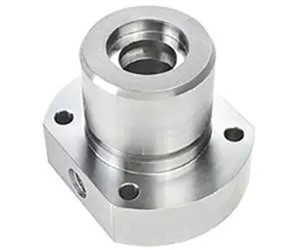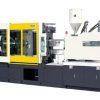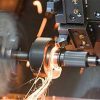
This is a frequently encountered problem, but it is also relatively easy to solve. When it is really not solved by technological means, it can be improved from the design and manufacture of molds, which can generally be solved.
1. Equipment:
(1) The capacity of the injection molding machine is small. When the quality of the product exceeds the actual maximum injection quality of the injection molding machine, it is obvious that the amount of material supplied will not make ends meet. If the quality of the product is close to the actual injection quality of the injection molding machine, there is a problem of insufficient plasticization. The heating time of the material in the barrel is insufficient. As a result, the appropriate melt cannot be provided to the Cnc Machining mold in time. In this case, the problem can only be solved by replacing the injection molding machine with a large capacity. Some plastics such as nylon (especially nylon 66) have a narrow melting range and a large specific heat. An injection molding machine with a large plasticizing capacity is required to ensure the supply of materials.
(2) The temperature displayed by the thermometer is not true, the bright high is low, and the material temperature is too low. This is because the temperature control device such as thermocouple and its wiring or the temperature difference millivoltmeter fails, or because the heating coil far away from the temperature measurement point is aging or burned, heating failure has not been found or has not been repaired and replaced in time.
(3) The diameter of the inner hole of the cnc turning nozzle is too large or too small. If it is too small, due to the small flow diameter, the specific volume of the strip will increase, which will easily be cooled, block the feed channel or consume the injection pressure; The condition of low force. At the same time, plastics such as uhmw machining cannot reduce the viscosity due to the lack of large shear heat, which makes it difficult to fill the mold.
The nozzle is not well matched with the inlet of the main runner, and the overflow of the mold and the filling of the mold are often unsatisfactory. The nozzle itself has high flow resistance or is blocked by foreign matter, plastic carbonized deposits, etc.; the spherical surface of the nozzle or the main runner inlet is damaged or deformed, which affects the good cooperation with the other party; edm Machining faults or deviations cause the nozzle and the main runner axis to have an inclination displacement or the axial pressing surface to separate; the nozzle ball diameter is larger than the main runner entrance ball diameter, due to the gap at the edge, the nozzle axis gradually increases under the squeeze of the overflow The pushing force will cause the plastic gear to be dissatisfied.
(4) The plastic frit blocks the feeding channel. Because the plastic is partially melted and agglomerated in the hopper dryer, or the temperature in the feed section of the barrel is too high, or the plastic grade is not selected properly, or the plastic contains too much lubricant, the plastic will enter the feed port or screw at the reduced diameter position. Premature melting in the deep groove of the screw end, the pellets and the melt are bonded to each other to form a “bridge”, which blocks the channel or envelops the screw, and slides circularly with the screw rotation, and cannot move forward, causing interruption of feeding or irregular fluctuations . This situation can only be fundamentally solved after the passage is cut through and the material blocks are eliminated.
(5) The nozzle cold material enters the mold. Injection molding machines usually only install straight-through nozzles due to pressure loss. However, if the temperature of the front end of the barrel and the nozzle is too high, or there is too much material at the front end of the barrel under high pressure, “salivation” will occur, which will cause the plastic to accidentally enter the main runner entrance before the injection is started and the plastic mold is open. And it becomes hard under the cooling effect of the template, which prevents the melt from entering the cavity smoothly. At this time, the temperature of the front end of the barrel and the nozzle should be lowered, the storage capacity of the barrel should be reduced, and the back pressure should be reduced to avoid excessive melt density at the front end of the barrel.
(6) The injection cycle is too short. Due to the short cycle, the material temperature is too late to keep up, which will also cause material shortage, especially when the voltage fluctuates greatly. The period should be adjusted accordingly according to the supply voltage. Generally, the injection and holding pressure time are not considered during the adjustment. The main consideration is to adjust the time from the completion of the holding pressure to the return of the screw, which does not affect the filling and molding conditions, and can extend or shorten the preheating time of the pellets in the barrel.
2. Mould:
(1) The mold casting system is defective. The flow channel is too small, too thin or too long, which increases fluid resistance. The main runner should increase the diameter, and the runner and branch runner should be round. The runner or the mouth is too large, and the injection force is insufficient; the runner and gate are blocked by impurities, foreign matter or carbide; the runner and gate are rough with scars, or have sharp angles, and the surface roughness is poor, which affects the material flow;
The runner does not have a cold slug well or the cold slug well is too small, and the opening direction is wrong; for multi-cavity molds, the runner and gate size distribution should be carefully arranged, otherwise there will be only the main runner or the thick and short gate. The situation where the cavity can be filled but other cavities cannot be filled. The diameter of the runner should be increased appropriately to reduce the pressure drop of the melt flowing to the end of the runner, and the gate of the cavity farther from the main runner should be enlarged to make the injection pressure and material flow velocity of each cavity basically the same.
(2) The mold design is unreasonable. The mold is too complex, with many turns, improper selection of the feed inlet, too narrow runner, insufficient number of gates or improper form; the partial section of the product is very thin, the thickness of the entire product or part should be increased, or an auxiliary should be set near the insufficient filling Runner or gate;
It is not uncommon for inadequate venting measures in the cavity to cause dissatisfaction with the parts. This defect mostly occurs in the corners of the product, deep recesses, thin-walled parts surrounded by thick-walled parts, and thin-walled parts formed by side gates. The bottom of the bottom shell, etc.
The design to eliminate this defect includes opening effective vents, selecting a reasonable gate position to make the air easy to discharge in advance, and when necessary, deliberately making a certain part of the trapped area of the cavity into an insert to make the air escape from the insert. Gap overflow; for multi-cavity molds that are prone to unbalanced gate distribution, the number of injection cavities should be reduced if necessary to ensure that other cavity parts are qualified.
3. Process:
(1) Improper feed adjustment, lack of material or excessive material. Inaccurate feeding metering or abnormal feeding control system operation, abnormal injection cycle caused by injection molding machine or mold or operating conditions, low pre-plastic back pressure, or low particle density in the barrel may cause material shortage. For large particles, Pellets with many voids and plastics with large crystalline specific volume changes, such as polyethylene, polypropylene, nylon, etc., as well as plastics with higher viscosity, such as ABS, should be adjusted to a higher volume. When the temperature of the material is high, the volume should be adjusted.
When there is too much material at the end of the barrel, the screw will consume extra injection pressure to compress and push the excess stock in the barrel during injection, which greatly reduces the effective injection pressure of the plastic entering the mold cavity. The product is difficult to fill.
(2) The injection pressure is too low, the injection time is short, and the plunger or screw returns too early. Molten plastic has higher viscosity and poor fluidity at lower working temperature, so it should be injected at higher pressure and speed. For example, in the production of ABS color parts, the high temperature resistance of the colorant limits the heating temperature of the barrel, which has to be compensated by higher injection pressure and longer injection time than usual.
(3) The injection speed is slow. The injection speed is of great significance for some products with complex shapes, large thickness changes, and long processes, as well as plastics with high viscosity, such as toughened ABS. When the product cannot be filled with high pressure, high-speed injection of ptj machining parts should be considered to overcome the problem of filling dissatisfaction.
(4) The material temperature is too low. The temperature of the front end of the barrel is low, and the viscosity of the molten material entering the cavity rises too early to the point where it is difficult to flow due to the cooling effect of the mold, which hinders the filling of the far end; the rear section of the barrel is a plastic with low temperature and high viscosity Difficult flow hinders the forward movement of the tsmachining screw. As a result, it seems that the pressure displayed by the pressure gauge is sufficient, but the melt actually enters the cavity at low pressure and low speed;
If the nozzle temperature is low, it may be that the nozzle is in contact with the cold mold for a long time during the fixed feeding and loses heat, or the nozzle heating ring is insufficiently heated or has poor contact, resulting in low temperature of the material, which may block the feeding channel of the mold; if the mold does not have cold material Well, with self-locking nozzles and post-feeding procedures, the nozzles can maintain the necessary temperature; the nozzle is too cold when it is just turned on, and sometimes a flame gun can be used for external heating to accelerate the temperature of the nozzle.
Four, raw materials:
Plastic has poor fluidity. Plastic Machining Service often uses recycled materials, and recycled materials often reflect a tendency to increase viscosity. The experiment pointed out that the unit volume density of molecular chain scission generated by oxidative cracking increased, which increased the viscosity of the flow in the barrel and cavity, and the regenerated scraps promoted the production of more gaseous substances, which caused the injection pressure to be lost. Increased, causing difficulty in filling the mold.
In order to improve the fluidity of the plastic, it should be considered to add external lubricants such as stearic acid or its salts, preferably silicone oil (viscosity 300~600cm2/s). The addition of lubricants not only improves the fluidity of the plastic, but also improves the stability and reduces the air resistance of gaseous substances.







